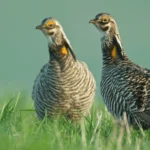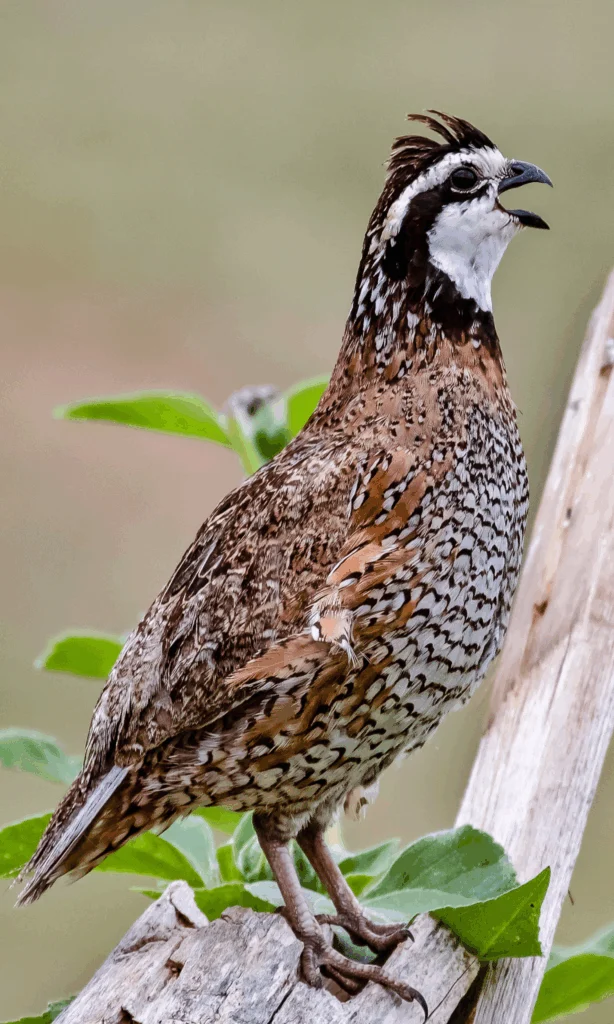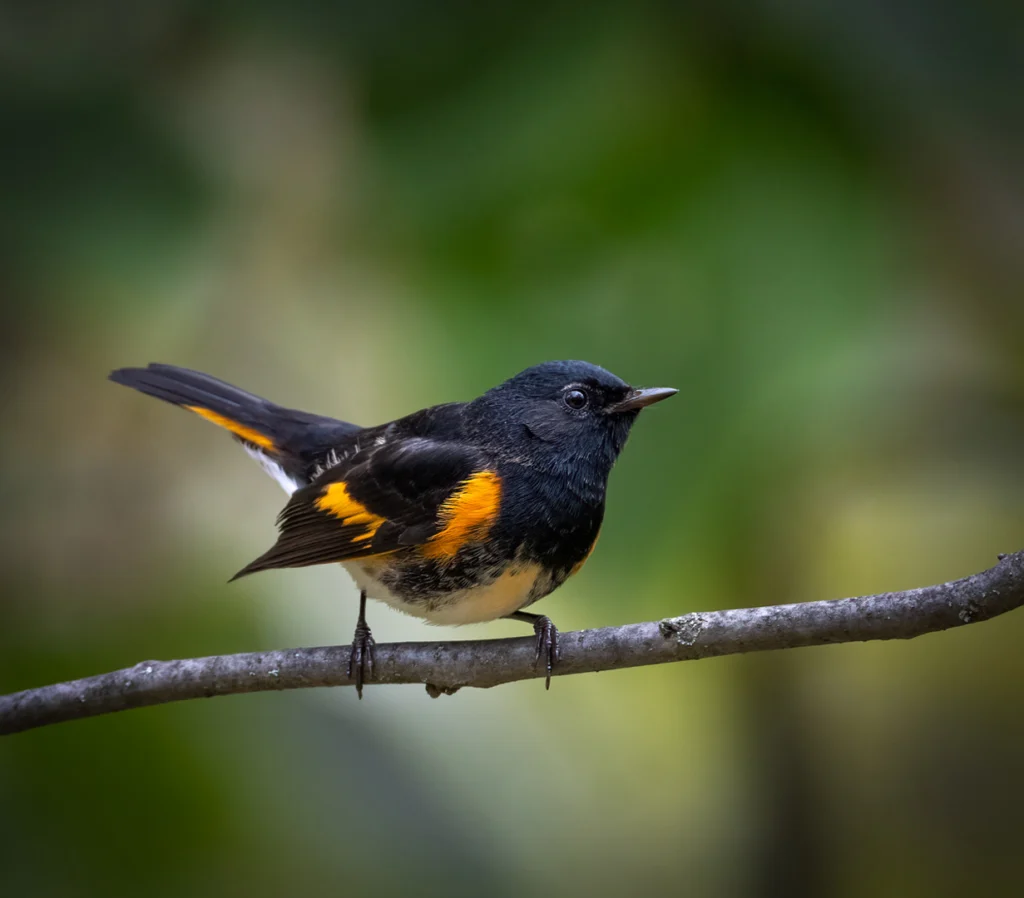
Overview
About
The Northern Bobwhite, also known as Virginia Quail or Virginia Partridge, is in the same family as the Montezuma and Scaled Quails, but the bobwhite is the only native quail species in the eastern United States. This delightfully round little quail is capable of strong, short bursts of flight — particularly when fleeing predators — though they prefer to walk or run, scuttling about under the dense, low cover of vegetation in grasslands, agricultural fields, and open forests.
The Northern Bobwhite is more often heard than seen, its namesake whistled bob-white! call sounding from the brushy undergrowth, where their dappled brown-and-white plumage provides excellent camouflage. But sometimes, especially when calling in spring, males will occupy highly visible locations, perching atop fenceposts and tree limbs.
A popular game bird, the Northern Bobwhite has a whopping 22 subspecies across its range, one of which — the Masked Bobwhite — is federally listed as Endangered. Its status as a game bird has made it one of the most well-studied birds in the world, and scientists have observed sharp declines, likely owing to multiple causes that include habitat loss and the increased use of pesticides.
Threats
Populations of Northern Bobwhite plunged between 1966 and 2019, resulting in an overall decline of 81 percent, according to the North American Breeding Bird Survey. Partners in Flight considers the Northern Bobwhite as a “Common Bird in Steep Decline.” For years, an explanation for such drastic declines has been elusive. However, most biologists agree that multiple causes are to blame.
Habitat Loss
The most likely cause for the loss of Northern Bobwhite is habitat loss due to fire suppression, mechanization of agriculture, and fragmentation and loss of suitable habitat to urban development.
Pesticides & Toxins
The increased use of pesticides is also thought to be a culprit behind this steep decline — a worrisome trend also noted in other birds sharing similar habitats, including the Loggerhead Shrike.
Conservation Strategies & Projects
Northern Bobwhites and other grassland species need our help to overcome the threats they face from habitat loss, pesticides, and other dangers. With science as our foundation, and with inclusion and partnership at the heart of all we do, we take bold action for grassland birds.
Restoring Habitat
Northern Bobwhites respond positively and quickly to habitat enhancement on working lands. ABC’s work with landowners in the Oaks and Prairies Joint Venture through initiatives such as the Grassland Restoration Incentive Program (GRIP) has helped to restore habitat for Northern Bobwhites. ABC also joins forces with groups such as the National Bobwhite and Grassland Initiative and the Central Hardwoods Joint Venture to improve habitat for this species.
Avoiding Pesticides & Toxins
ABC continues to work for the regulation of harmful pesticides. Our 2023 report compiles the last decade’s research on the harmful impacts of neonicotinoids, a widely used insecticide proven to have catastrophic effects on grassland birds such as the Northern Bobwhite, the insect populations they depend on for food, and nearby aquatic ecosystems.
Supporting Petitions & Advocacy
ABC advocates for measures to be included in key legislation that funds bird conservation programs, including the Farm Bill, which helps the Northern Bobwhite and other grassland species. You can help shape policy for the better by telling lawmakers to prioritize birds, habitat, and bird-friendly measures.
Bird Gallery
The Northern Bobwhite is a small quail with a rotund, reddish-brown body marked with intricate black, white, and brown scaled or speckled patterns. There are 22 recognized subspecies with plumage that varies across the species’ range, but most males have very distinct black and white markings on the head, with white stripes above the eyes and on the forehead and throat, which are offset by a thick black outline. Females have a buffy throat and eye stripe.

Sounds
Although best known for its namesake whistle, the Northern Bobwhite also employs a wide variety of other calls for different reasons. This repertoire has been grouped into different categories comprising group movement, feeding, predator avoidance, and reproduction.
Both male and female Northern Bobwhites give a number of group movement calls (also called separation or scatter calls) that reunite separated pairs and coveys, or maintain contact while feeding. Adult bobwhites with chicks give a special soft call while using their beaks to direct the young ones towards food. When threatened by predators, the bobwhite’s calls vary according to the nature of the threat (Is it coming from the ground or the air? Is it approaching or has it passed by?). Yet another set of calls is employed during the courtship, breeding, and nesting phases of this bird’s life cycle.
Andrew Spencer, XC109879. Accessible at www.xeno-canto.org/109879.
Mike Nelson, XC103972. Accessible at www.xeno-canto.org/103972.
Habitat
Northern Bobwhites make their homes year-round in a variety of open habitats, typically preferring areas that have been recently disturbed by fire, farming, or other events over mature woodlands.
- Lives in grasslands, open pine-hardwood or pine forests, agricultural fields, brushy meadows, overgrown fields, and rangelands
- Requires woody cover to keep foraging habitat clear of snow in the northern parts of its range

Range & Region

Specific Area
Eastern North America, the Caribbean
Range Detail
Northern Bobwhites are widespread in eastern North America and south to southern Mexico. There are introduced populations in the Pacific Northwest and in some parts of the Caribbean.
Did you know?
Though the Northern Bobwhite is generally nonmigratory, bobwhites in the Smoky Mountains venture to higher elevation habitats for the breeding season.
Life History
Each fall, Northern Bobwhites form groups, or coveys, of three to 20 birds. At night, these coveys roost in a close-packed, outward-facing circle with their tails pointing toward the center, probably to conserve heat and stay alert for predators. As a very social species, they stay in coveys until the beginning of nesting season each spring, when they begin to pair off.

Diet
Northern Bobwhites forage on the ground as a group, usually in early morning and late afternoon. Plant material such as leaves, buds, weed and grass seeds, berries, and grains make up the bulk of their diet. Depending on the time of year and the age of the individual, it will add protein to its diet in the form of small invertebrates such as grasshoppers, beetles, spiders, and crickets. Nesting females and chicks need the most protein for egg-laying and growth.
Courtship
Although seemingly monogamous during the nesting season, each member of a bobwhite pair may mate with several different partners, a strategy that ensures maximum genetic fitness and diversity. Males and females both perform courtship displays to attract mates and encourage pair bonding. Once a pair bond is formed, males are aggressive toward other males when females are present.
Nesting
Both sexes work to build the nest, a simple scrape on the ground lined with leaves and grasses. These birds often weave dry grass or weeds to form an arch around the nest, which hides it from potential predators. In some populations, the female will leave the male to incubate and hatch one nest while she starts another.
Eggs & Young
Female bobwhites lay large clutches of 12 to 16 eggs, which both parents incubate. The hatchlings are precocial (they emerge covered in down, able to walk, with eyes open) and leave the nest shortly after hatching. Young bobwhites are fed and cared for by their parents for several weeks after leaving the nest. In a good nesting season and in suitable habitat, female bobwhites can raise several broods per year.

















